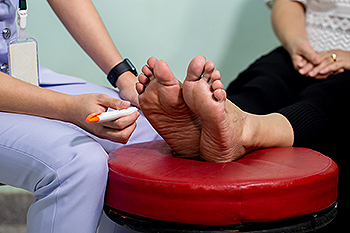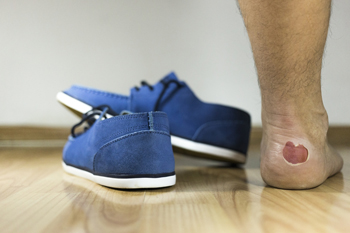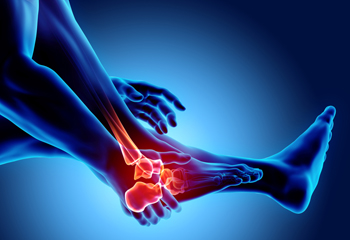Connect With Us
Blog
Items filtered by date: May 2022
Preventative Foot Care for Diabetics

Anyone with diabetes is vulnerable to foot problems as a result of high blood sugar levels, which can damage the nerves in the legs and feet. The resulting numbness makes it more difficult to detect sores or cuts and to notice if shoes are too tight. It becomes harder to feel pain, temperature, and pressure, putting your feet in danger of infection. To avoid serious complications, such as foot ulcers, gangrene, or even amputation, a daily foot care plan is imperative for diabetics. First, check your feet daily for cuts, sores, or changes in color. Next, wash and carefully dry your feet before applying moisturizing cream to ward off dry or cracked skin. Avoid putting lotion between the toes. Protecting your feet is also essential. Wear shoes that fit properly, and avoid walking barefoot. Stop smoking, as it can further the damage to your blood vessels and can increase the risk of foot ulcers. Finally, anyone with diabetes is wise to have regular checkups with a podiatrist to monitor their foot health and stay ahead of problems.
Diabetic foot care is important in preventing foot ailments such as ulcers. If you are suffering from diabetes or have any other concerns about your feet, contact Philip K. Schrumpf, DPM from Active Feet Clinic. Our doctor can provide the care you need to keep you pain-free and on your feet.
Diabetic Foot Care
Diabetes affects millions of people every year. The condition can damage blood vessels in many parts of the body, especially the feet. Because of this, taking care of your feet is essential if you have diabetes, and having a podiatrist help monitor your foot health is highly recommended.
The Importance of Caring for Your Feet
- Routinely inspect your feet for bruises or sores.
- Wear socks that fit your feet comfortably.
- Wear comfortable shoes that provide adequate support.
Patients with diabetes should have their doctor monitor their blood levels, as blood sugar levels play such a huge role in diabetic care. Monitoring these levels on a regular basis is highly advised.
It is always best to inform your healthcare professional of any concerns you may have regarding your feet, especially for diabetic patients. Early treatment and routine foot examinations are keys to maintaining proper health, especially because severe complications can arise if proper treatment is not applied.
If you have any questions please feel free to contact our office located in Missoula, MT . We offer the newest diagnostic and treatment technologies for all your foot and ankle needs.
Finding the Best Running Shoe for Your Feet

It’s not about the looks or the status, it’s about the fit. When in doubt, experts recommend that when shopping for running shoes to put fit over fashion, brand, or price. Shoes that are too tight can cause blisters, while shoes that are too wide can hurt your toes. Shoes that fit poorly can cause tendonitis, pinched nerves, heel pain, ankle sprains, and stress fractures. Signs that your shoes don’t fit properly include heel slippage, numbness on the top of the feet, and bruising on the toes. The best way to prevent these from occurring is to measure your feet while also wearing the socks you will use as you run. Check your foot measurements periodically, as foot size can change if you gain or lose weight. A rule of thumb is to have at least a half-inch of room between your toes and the end of the shoe. Running shoes usually run about half a size larger than street shoes, to allow for the feet to expand as you run. Try on several types of shoes before making a decision. If you need guidance on the best running shoe for you, please consult a podiatrist.
You should always make sure your running shoes fit properly in order to avoid injury. For more information, contact Philip K. Schrumpf, DPM from Active Feet Clinic. Our doctor can provide the care you need to keep you pain-free and on your feet.
Choosing the Right Running Shoe for Your Foot Type
Improper shoe sizing can cause a myriad of problems for your feet. Shoes that don’t fit you properly can lead to muscular imbalances in your body, which can result in foot, knee, and hip injuries.
Tips for Finding the Right Running Shoe
- Make sure you have a thumb’s width of wiggle room between the end of your longest toe and the front of the shoe.
- There should be little to no slipping at the heel
- Don’t assume your size in one shoe brand will be your size in another
- Do not lace up your shoes too tightly
- Walk around in the store with your new shoes before you buy them
If you have any questions please feel free to contact our our office located in Missoula, MT . We offer the newest diagnostic and treatment technologies for all your foot and ankle needs.
Why Do Blisters Develop on the Feet?

A blister is a small area that looks like a bubble and can be bothersome when it develops on the feet. It happens as a result of excess friction from wearing shoes or socks that do not fit correctly. The consistent rubbing of the material on the skin can lead to a blister. It is filled with a protective liquid, which protects the area as new skin develops. It will gradually drain on its own, when it is no longer needed for protection. Many people choose to wear a bandage over the blister, which may be helpful in preventing premature drainage. Other reasons a blister may develop can include frostbite, sunburn, or possibly an allergic reaction from an insect bite. Some patients find that pressure is reduced in the shoes when orthotics are worn, or when socks that have extra padding are worn. Research has indicated that having dry skin may lead to getting blisters, in addition to wearing shoes without socks and increasing speed and mileage while running or walking. If you have blisters on your feet, please confer with a podiatrist for additional caring and prevention techniques.
Blisters may appear as a single bubble or in a cluster. They can cause a lot of pain and may be filled with pus, blood, or watery serum. If your feet are hurting, contact Philip K. Schrumpf, DPM of Active Feet Clinic. Our doctor can provide the care you need to keep you pain-free and on your feet.
Foot Blisters
Foot blisters are often the result of friction. This happens due to the constant rubbing from shoes, which can lead to pain.
What Are Foot Blisters?
A foot blister is a small fluid-filled pocket that forms on the upper-most layer of the skin. Blisters are filled with clear fluid and can lead to blood drainage or pus if the area becomes infected.
Symptoms
(Blister symptoms may vary depending on what is causing them)
- Bubble of skin filled with fluid
- Redness
- Moderate to severe pain
- Itching
Prevention & Treatment
In order to prevent blisters, you should be sure to wear comfortable shoes with socks that cushion your feet and absorb sweat. Breaking a blister open may increase your chances of developing an infection. However, if your blister breaks, you should wash the area with soap and water immediately and then apply a bandage to the affected area. If your blisters cause severe pain it is important that you call your podiatrist right away.
If you have any questions, please feel free to contact our office located in Missoula, MT . We offer the newest diagnostic and treatment technologies for all your foot care needs.
Seeing a Podiatrist for Rheumatoid Arthritis of the Feet

Rheumatoid arthritis (RA) is a chronic inflammatory disease that can affect the joints of the feet. One who has RA of the feet often experiences pain and swelling in the feet, which can impair functioning and quality of life. Though there is no cure for this condition, treatments focus on preventing the disease from progressing by reducing or stopping joint inflammation. One might experience relief from one or a combination of RA management regimens, such as anti-inflammatory medication, more supportive footwear, orthotics, physical or occupational therapy, and even surgery. If you are experiencing pain from RA of the feet, consult with a podiatrist who can help devise a treatment plan to help relieve uncomfortable symptoms and preserve joint structure and function.
Because RA affects more than just your joints, including the joints in your feet and ankles, it is important to seek early diagnosis from your podiatrist if you feel like the pain in your feet might be caused by RA. For more information, contact Philip K. Schrumpf, DPM of Active Feet Clinic. Our doctor will assist you with all of your podiatric concerns.
What Is Rheumatoid Arthritis?
Rheumatoid Arthritis (RA) is an autoimmune disorder in which the body’s own immune system attacks the membranes surrounding the joints. Inflammation of the lining and eventually the destruction of the joint’s cartilage and bone occur, causing severe pain and immobility.
Rheumatoid Arthritis of the Feet
Although RA usually attacks multiple bones and joints throughout the entire body, almost 90 percent of cases result in pain in the foot or ankle area.
Symptoms
- Swelling and pain in the feet
- Stiffness in the feet
- Pain on the ball or sole of feet
- Joint shift and deformation
Diagnosis
Quick diagnosis of RA in the feet is important so that the podiatrist can treat the area effectively. Your doctor will ask you about your medical history, occupation, and lifestyle to determine the origin of the condition. Rheumatoid Factor tests help to determine if someone is affected by the disease.
If you have any questions please feel free to contact our office located in Missoula, MT . We offer the newest diagnostic and treatment technologies for all your foot and ankle needs.
Gout Pain Can Be Managed
When to Use Heat or Ice to Reduce Pain

It is common for many people to reach for either an ice pack or a heating pad when they experience minor toe, foot or ankle pain. Heat and ice do frequently work to relieve discomfort, but knowing which one to use can be confusing. The first thing to know is that heat causes blood vessels to open (dilate), and ice causes them to constrict. Heat brings more blood to the injured area, helping to ease pain, spasm and stiffness. It is usually recommended for aching muscles, cramps or stiffness. A heat compress should not be overly hot, or it can burn the skin. A cloth or towel between the compress and the skin is suggested. On the other hand, it is not a good idea to use heat on a new injury, because it can add to any bleeding under the skin. Ice is more often used immediately after an injury to reduce pain, swelling and bruising, and to help numb the area. It is wise to place a cloth or towel between the ice pack and the skin and to leave the ice pack on for no longer than 30 minutes. After a severe ankle injury, especially if you think you may have torn a ligament or broken a bone, it is suggested that you visit a podiatrist immediately for examination, diagnosis and treatment.
Wound care is an important part in dealing with diabetes. If you have diabetes and a foot wound or would like more information about wound care for diabetics, consult with Philip K. Schrumpf, DPM from Active Feet Clinic. Our doctor will assess your condition and provide you with quality foot and ankle treatment.
What Is Wound Care?
Wound care is the practice of taking proper care of a wound. This can range from the smallest to the largest of wounds. While everyone can benefit from proper wound care, it is much more important for diabetics. Diabetics often suffer from poor blood circulation which causes wounds to heal much slower than they would in a non-diabetic.
What Is the Importance of Wound Care?
While it may not seem apparent with small ulcers on the foot, for diabetics, any size ulcer can become infected. Diabetics often also suffer from neuropathy, or nerve loss. This means they might not even feel when they have an ulcer on their foot. If the wound becomes severely infected, amputation may be necessary. Therefore, it is of the upmost importance to properly care for any and all foot wounds.
How to Care for Wounds
The best way to care for foot wounds is to prevent them. For diabetics, this means daily inspections of the feet for any signs of abnormalities or ulcers. It is also recommended to see a podiatrist several times a year for a foot inspection. If you do have an ulcer, run the wound under water to clear dirt from the wound; then apply antibiotic ointment to the wound and cover with a bandage. Bandages should be changed daily and keeping pressure off the wound is smart. It is advised to see a podiatrist, who can keep an eye on it.
If you have any questions, please feel free to contact our office located in Missoula, MT . We offer the newest diagnostic and treatment technologies for all your foot care needs.
Blog Archives
- August 2024
- July 2024
- June 2024
- May 2024
- April 2024
- March 2024
- February 2024
- January 2024
- December 2023
- November 2023
- October 2023
- September 2023
- August 2023
- July 2023
- June 2023
- May 2023
- April 2023
- March 2023
- February 2023
- January 2023
- December 2022
- November 2022
- October 2022
- September 2022
- August 2022
- July 2022
- June 2022
- May 2022
- April 2022
- March 2022
- February 2022
- January 2022
- December 2021
- November 2021
- October 2021
- September 2021
- August 2021
- July 2021
- June 2021
- May 2021
- April 2021
- March 2021
- February 2021
- January 2021
- December 2020
- November 2020
- October 2020
- September 2020
- August 2020
- July 2020
- June 2020
- May 2020
- April 2020
- March 2020
- February 2020
- January 2020
- December 2019
- November 2019
- October 2019
- September 2019
- August 2019
- July 2019
- June 2019
- May 2019
- April 2019
- March 2019

